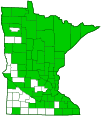white admiral
(Limenitis arthemis arthemis)
Conservation • Description • Habitat • Ecology • Distribution • Taxonomy
|
|
|||||||||||||
Description |
White admiral is a large brush-footed butterfly with a 3″ to 3½″ wingspan. The male and female are identical in appearance but the female is slightly larger than the male. The upperside of both wings is dark bluish-black with a broad, white, postmedial band. The forewing is rounded at the tip. It has a few white spots near the apex and a row of light blue, crescent-shaped, marginal spots. The hindwing has a row of reddish-orange submarginal spots and two rows of light blue, crescent-shaped, marginal spots. The underside of both wings is dark brown with the white band, submarginal spots, and subapical spots carried through from the upperside. Both wings also have orangish-red and blue spots near the leading edge and two rows of light blue, crescent-shaped, marginal spots. The caterpillar is up to 2″ long. It is a bird dropping mimic. The thorax and abdomen are mottled medium and dark olive green. A pair of long, black, spiny, branched projections (scoli) extend over the head from a hump on the second thoracic segment. There is a pair of large, greenish-yellow humps on the on the upper (dorsal) side of the second abdominal segment. Each hump is tipped with a small cluster of short white spines. There are similar, smaller humps on the seventh and eighth abdominal segments. A white subspiracular stripe extends from the second to the last abdominal segment. A white “saddle” on the dorsal surface from the fourth through sixth abdominal segments extends down the sides near the middle and merges with the subspiracular stripe. The head is brown and has a pair of short, brown scoli. The prolegs are brown. Mature caterpillars are found from late May onward. |
Size |
3″ to 3½″ wingspan |
Similar Species |
| No similar species |
Habitat |
Forest edges and openings of deciduous broad-leaf forests and or mixed evergreen forests dominated by aspen or birch; roadsides, trails. |
Ecology |
Season |
Two broods: Late May to August; and a partial generation August to early September |
Behavior |
Adult butterflies are often seen sunning themselves on gravel roads. |
Life Cycle |
In the fall the third stage caterpillar of the second brood forms a shelter (hibernaculum) by rolling a leaf and tying it with silk. It overwinters in the hibernaculum. The range of this subspecies overlaps that of the red-spotted purple in the lower third of the state. Where the ranges overlap the subspecies interbreed and produce offspring with intergrading characteristics. |
Larva Hosts |
Usually leaves of birch, willow, quaking aspen, and chokecherry, but also American basswood, plains cottonwood, hawthorn, oak, serviceberry, and other trees. |
Adult Food |
Sap flows, rotting fruit, aphid honeydew, carrion, dung; rarely flower nectar. |
Distribution |
||
|
Sources This map includes sightings of the hybrid white admiral × red-spotted purple (Limenitis arthemis arthemis × astyanax) in southeastern Minnesota from iNaturalist.org. |
|
| 6/26/2024 | ||
Occurrence |
||
Common |
||
Taxonomy |
|
Order |
|
Superfamily |
Papilionoidea (Butterflies) |
Family |
|
Subfamily |
Limenitidinae (admirals and allies) |
Tribe |
Limenitidini |
Subtribe |
Limenitidina (admirals) |
Genus |
Limenitis |
Species |
Limenitis arthemis (red-spotted admiral) |
Subordinate Taxa |
|
|
|
Synonyms |
|
Basilarchia arthemis arthemis |
|
Common Names |
|
white admiral |
|
Glossary
Hibernaculum
A structure where an animal or insect hibernates in the winter.
Proleg
A fleshy structure on the abdomen of some insect larvae that functions as a leg, but lacks the five segments of a true insect leg.
Pupa
The life stage of some insects undergoing transformation. In caterpillars, the chrysalis.
Scolus
A spiny, branched projection from a larval body wall, the branches terminating with a single stiff, hair-like or bristle-like tip.
Seta
A usually rigid bristle- or hair-like structure on butterflies and moths used to sense touch. Plural: setae.
Spiracle
A small opening on the surface of an insect or arachnid through which it breathes.
Visitor Photos |
||
Share your photo of this insect. |
||
This button not working for you? |
||
Bobbi Johnson |
||
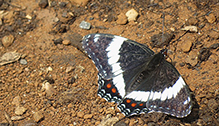 |
|
|
Beulah Morrison |
||
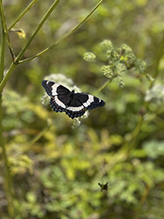 |
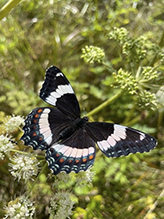 |
|
Came across this little beauty on what should have been my sons 30th birthday! So special. |
||
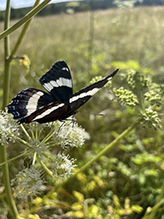 |
||
Amanda Thelen |
||
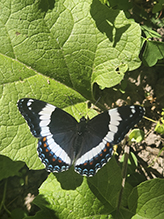 |
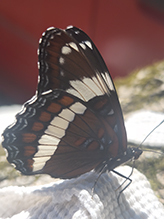 |
|
Bill Reynolds |
||
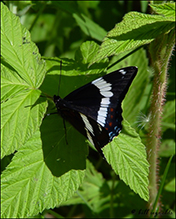 |
||
MinnesotaSeasons.com Photos |
||
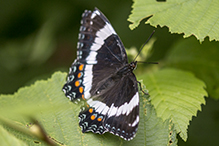 |
 |
|
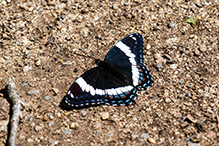 |
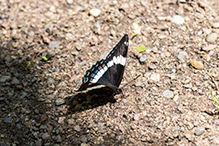 |
|
 |

Slideshows |
White Admiral |
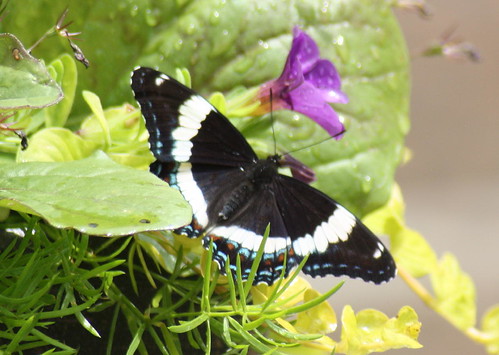
|
About
Copyright DianesDigitals |
White Admiral Butterfly |
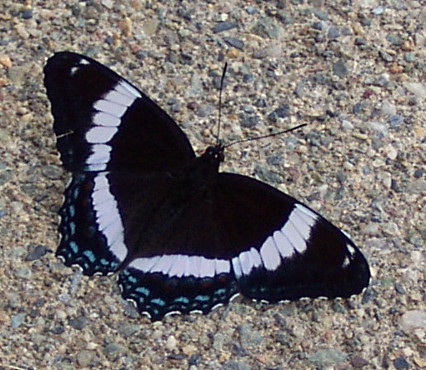
|

Visitor Videos |
||
Share your video of this insect. |
||
This button not working for you? |
||
|
Other Videos |
||
White Admiral (Limenitis arthemis) |
About
Published on Jul 12, 2013 In this video, a white admiral (Limenitis arthemis arthemis) is shown moving from flower to flower in a long meadow. This video was recorded on July 3, 2013 just within the White Mountain National Forest of New Hampshire. |
White Admiral Butterfly (Nymphalidae: Limenitis arthemis) on Walkway |
About
Uploaded on Jul 3, 2011 Photographed at Nisswa, Minnesota (01 July 2010). |
White Admiral (Nymphalidae: Limenitis arthemis) on Leaf |
About
Uploaded on Aug 7, 2010 Photographed at Itasca State Park, Minnesota (06 August 2010). |

Visitor Sightings |
||
Report a sighting of this insect. |
||
This button not working for you? |
||
Jon Jasinski |
Location: Paradise, Michigan This is the first time in many years that we have seen these. There is a lot of them too. |
|
| Patty Kenyon 8/4/2023 |
Location: Voyageurs National Park Plentiful |
|
| Beulah Morrison 8/28/2022 |
Location: Melrose Hill, Hays River Road, Cape Breton Island NS Came across this little beauty on what should have been my sons 30th birthday! So special. |
 |
| Michelle Strand 6/11/2020 |
Location: Crystal MN Landed on my bench on my deck. |
|
| Chris Walker 6/17/2017 |
Location: Tamarac I grew up in lower Michigan, where we don’t have white admirals, but knew Weidemeyer's admiral from working in New Mexico -- so at first glance I thought it was Weidemeyer's admiral, and thought “how big is their range?!?!” But I’m better now, lol... |
|
MinnesotaSeasons.com Sightings |
||

Created: Last Updated: © MinnesotaSeasons.com. All rights reserved. |
